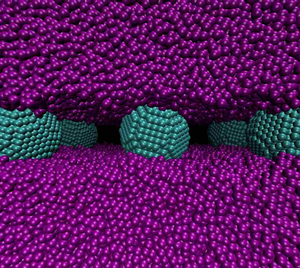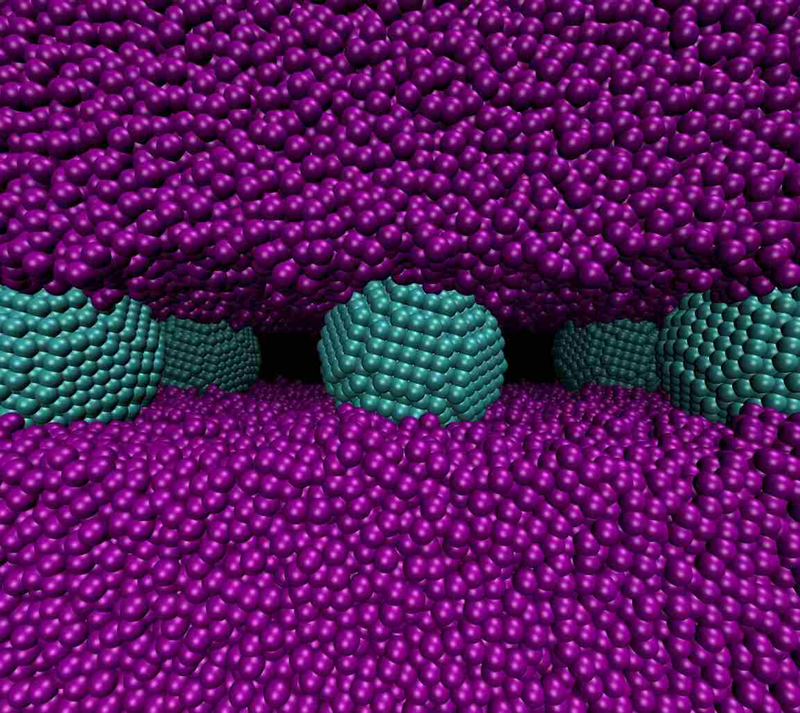Lubricant for Liquids
Two liquids in contact cannot usually slide by each other at all, because their molecules are in intimate contact. But in Physical Review Letters, a French team suggests that this motion can be lubricated by placing tiny beads at the liquids’ interface, to act as ball bearings. If the concept can be achieved in experiments, it could provide new flexibility in manipulating fluid flow.
In recent years, researchers have created “superhydrophobic” surfaces that use arrays of tiny raised pillars to allow water to flow with very low friction. First, the surface of each pillar is hydrophobic, like wax, so water “beads up” on it. But in addition, the collection of pillars is much more hydrophobic than a flat hydrophobic surface would be, because the liquid bridges across the tops of the closely-spaced pillars and slides as if on an air cushion.
Olivier Pierre-Louis and Laurent Joly of the University of Lyon 1 and the French National Center for Scientific Research (CNRS) wondered if a similar technique could modify the friction between two liquids. For example, in a microfluidics device that does some chemical processing, one might want two liquids to flow past one another easily and only mix at a specified location. To replace the pillars, they imagined placing an array of tiny spheres at the interface. The fluids would remain separated because the spheres would be hydrophobic, and surface tension would maintain an air gap in the regions between the spheres. “These kinds of interfaces have already been made experimentally,” Pierre-Louis says, but no one has measured their frictional properties. Using theoretical calculations and simulations, the researchers, working with student Quentin Ehlinger, now find that beads indeed dramatically reduce the friction.
The team quantified this friction using the so-called slip length. It’s derived from the concept of a “no-slip” condition when fluid flows across a solid surface: ideally, as you approach the surface from within the fluid, the flow speed falls to zero. In reality, however, the fluid velocity is not quite zero at the surface. Instead, to get to zero, you would need to extrapolate the plot of velocity versus position to a point slightly below the surface. This depth—the slip length—is often small enough to be ignored. But a long slip length means faster flow and less friction than a short one.
In the new work, the researchers theoretically study how the slip length for flow of one liquid past another is affected by the presence of hydrophobic beads. When the beads penetrate into the liquids somewhat, the surfaces take on a corrugated shape, forcing the liquid to flow around the beads, and causing resistance and thus a short slip length. In contrast, making the beads more hydrophobic flattens the surface, dramatically increasing the slip length, with calculated values as high as millimeters. “This kind of slip length will actually be among the largest slip lengths ever observed,” Pierre-Louis says. The researchers also confirmed these calculations using atomic-scale simulations.
Although any new tool for manipulating liquid flow is potentially useful, researchers haven’t previously thought much about the potential for reduced friction between liquids. Pierre-Louis imagines futuristic devices in which flow is channeled not by rigid walls but by other liquids. For example, jets of a fluid could flow into a pipe in a way that controllably restricts the flow of another liquid. More immediately, because the particles prevent the liquids from mixing, they could be useful in some “lab-on-a-chip” devices.
Pierre-Louis is hopeful that experimentalists will soon check these predictions. A big challenge, already a problem for the patterned solid surfaces, is that pressure against the interface can vary widely, depending on the local flow speed of the fluid. “Pressure is the biggest enemy for slip,” he says. It increases the penetration of the beads into the liquids, spoiling the reduced friction, and can eventually cause the air gap to collapse entirely.
“Pressure is the killer” for practical applications, agrees C.-J. Kim of the University of California, Los Angeles. He also suspects that the viscosity of the air between beads will spoil some of the improvement predicted when the beads are very hydrophobic. But the theoretical proposal may well stimulate further work, he says. “Immediately it made me think about how to test this in an experiment.”
–Don Monroe
Don Monroe is a freelance science writer in Murray Hill, New Jersey.





